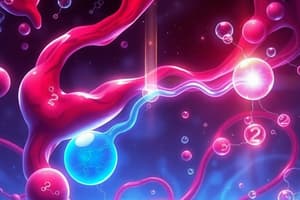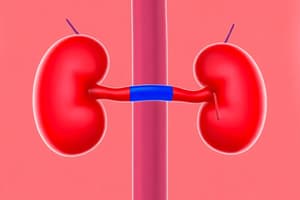Podcast
Questions and Answers
Why are nonpolar biomolecules poorly soluble in water?
Why are nonpolar biomolecules poorly soluble in water?
- They form stronger water-water interactions, excluding the nonpolar molecules.
- They readily replace water-water interactions, leading to their aggregation.
- They interfere with water-water interactions but cannot form energetically favorable water-solute interactions. (correct)
- They increase the dielectric constant of water, reducing its ability to dissolve solutes.
How does the geometry of a water molecule contribute to its unique properties?
How does the geometry of a water molecule contribute to its unique properties?
- Its tetrahedral arrangement of electron orbitals results in a polar molecule with strong cohesive properties. (correct)
- Its spherical symmetry minimizes intermolecular interactions, leading to a high vapor pressure.
- Its linear shape allows for maximum hydrogen bonding capacity.
- Its trigonal planar structure allows it to effectively dissolve nonpolar substances.
What is the significance of van der Waals interactions in biological molecules?
What is the significance of van der Waals interactions in biological molecules?
- They enable the formation of strong covalent bonds between lipids and carbohydrates.
- They contribute to the specific, three-dimensional structures of proteins, nucleic acids, polysaccharides and membrane lipids. (correct)
- They facilitate the solubility of nonpolar molecules in aqueous environments.
- They provide the primary force for protein folding and stabilization of nucleic acid structures.
Why is it important to consider equilibrium constants for ionization reactions in biological systems?
Why is it important to consider equilibrium constants for ionization reactions in biological systems?
How does the autoionization of water influence pH calculations?
How does the autoionization of water influence pH calculations?
What is the chemical characteristic of a buffer system and explain how this relates to the system's function?
What is the chemical characteristic of a buffer system and explain how this relates to the system's function?
How does the Henderson-Hasselbalch equation relate the pH of a solution to the pKa of a weak acid within that solution?
How does the Henderson-Hasselbalch equation relate the pH of a solution to the pKa of a weak acid within that solution?
Considering the role of water in biological systems, what implications arise from its high heat of vaporization?
Considering the role of water in biological systems, what implications arise from its high heat of vaporization?
How do the unique solvent properties of water influence the structure and function of proteins?
How do the unique solvent properties of water influence the structure and function of proteins?
In multicellular organisms, pH regulation within the extracellular fluids is tightly controlled. What is primarily responsible for achieving this constant pH?
In multicellular organisms, pH regulation within the extracellular fluids is tightly controlled. What is primarily responsible for achieving this constant pH?
Flashcards
Importance of Water Properties
Importance of Water Properties
The physical and chemical characteristics of water influence cellular structure and function.
Role of weak interactions
Role of weak interactions
Weak individually, but collectively strong influencers of biomolecule structure.
Water's Internal Cohesion
Water's Internal Cohesion
Attractions between adjacent water molecules that give liquid water great internal cohesion.
van der Waals Interactions
van der Waals Interactions
Signup and view all the flashcards
Water Ionization Products
Water Ionization Products
Signup and view all the flashcards
Acids and Bases Defined
Acids and Bases Defined
Signup and view all the flashcards
What are Buffers?
What are Buffers?
Signup and view all the flashcards
Henderson-Hasselbalch Equation
Henderson-Hasselbalch Equation
Signup and view all the flashcards
Cellular pH Maintenance
Cellular pH Maintenance
Signup and view all the flashcards
Ion product of water
Ion product of water
Signup and view all the flashcards
Study Notes
There is no text to generate study notes from.
Studying That Suits You
Use AI to generate personalized quizzes and flashcards to suit your learning preferences.




